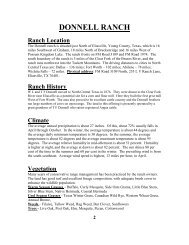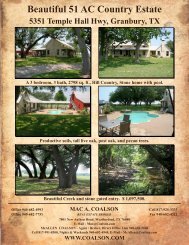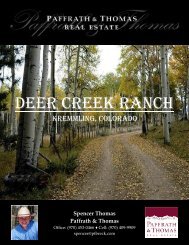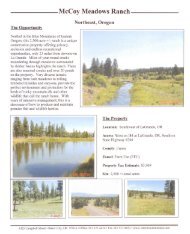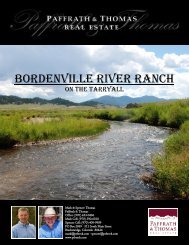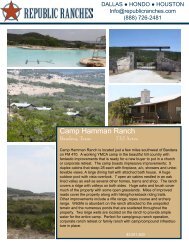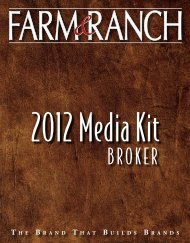Download Property Brochure - Farm & Ranch
Download Property Brochure - Farm & Ranch
Download Property Brochure - Farm & Ranch
Create successful ePaper yourself
Turn your PDF publications into a flip-book with our unique Google optimized e-Paper software.
The <strong>Ranch</strong> ranks among the largest cow-calf operations<br />
in Montana, currently running about 3,500 mother cows<br />
plus about 175 bulls and about 800 replacement heifers.<br />
According to an assessment conducted on the <strong>Ranch</strong> in<br />
June 2011 by Norman C. Wheeler & Associates, the <strong>Ranch</strong><br />
is currently rated at 5,200 Animal Units.<br />
As with any premier commercial cattle operation, bull<br />
selection is critical and the <strong>Ranch</strong> carefully evaluates their<br />
breeding stock on an annual basis. Replacement<br />
bulls are closely assessed based on their yearling<br />
Expected Progeny Difference (EPD). The<br />
purpose of EPD is to compare the genetic merit<br />
of the animal based on specific traits. Ultimately<br />
the bull has to have good “eye appeal.” Bulls are<br />
typically kept for six breeding years. Years of<br />
discipline in the selection of breeding stock has<br />
produced a uniform high-index cattle herd.<br />
According to Dan Freeman, the <strong>Ranch</strong> Manager,<br />
the history of producing high-index calves on the<br />
<strong>Ranch</strong> at weaning has commanded a premium<br />
from mid-west feeders and packers. Broken<br />
O calves historically gain 3.25 to 3.75 pounds<br />
per day, finish fast, and grade very high. The<br />
annual steer crops command top dollar and have<br />
developed a reputation for quality over the past<br />
20 years.<br />
First-calf heifers typically weigh around 1,100<br />
pounds and begin calving in early February,<br />
finishing up in late March, and typically produce calves<br />
averaging 80 pounds at birth. These heifers are synchronized<br />
to calve within the first three weeks in February. They calve<br />
in the main calving facility located along the Sun River<br />
just east of the Cattle Division where they can be closely<br />
monitored. This expansive facility is heated and contains<br />
over 100 jugs to accommodate the heifer herd during the<br />
initial calving rush in early February. Once the calf is on<br />
the ground, the pair is kept in the barn for about a day<br />
CATTLE OPERATION<br />
before the pairs are sexed into one of two holding lots<br />
near the barn where they are held for three to four days<br />
to ensure the new calf has taken to its mother and both<br />
are healthy.<br />
By February 20th, any remaining un-calved heifers are split<br />
between the Freeman Barn and the New Barn Calving<br />
Facilities to be put in with the older cows as they begin<br />
the calving process. The average birth weights on the calves<br />
from the older cows typically run about 80 to 90 pounds.<br />
As the remaining heifers calve out, they are then trucked<br />
back to the Main Calving Barn to be sexed and put with<br />
the other first-calf heifers. The older cows have historically<br />
calved out in lots near each of the calving facilities.<br />
At birth, all calves are inoculated with Vitamin A and<br />
tagged. Once calving wraps up and the pairs are sexed,<br />
the steer pairs are turned out south of Highway 21 to the<br />
6<br />
high-protein improved pastures and native grasses. They<br />
continually move to the east-southeast through the deeded<br />
and state lease lands until they end up at the Pick Hammer<br />
Unit located at the very south end of the <strong>Ranch</strong> to utilize<br />
the best hard grass for the most efficient gain. The heifer<br />
pairs graze the sub-irrigated pastures north of the Sun River<br />
and are moved from the pastures west to east and eventually<br />
to the Harris Unit. By mid-May the bulls are turned out<br />
with the cow herd to begin the breeding cycle.<br />
Calves are weaned in late October and given<br />
a preconditioning and an eight-way shot.<br />
The 2011 weaned steer calves averaged 682<br />
pounds. In 2011 the heifer calves averaged 630<br />
pounds. Steers are shipped immediately after<br />
weaning to commercial feedlots in Nebraska.<br />
The heifer calves are weaned directly from the<br />
Harris Unit and trucked to the <strong>Ranch</strong> feedlot.<br />
The replacement heifers will go through three<br />
separate culls until the final herd of heifers to<br />
be bred is established in late March.<br />
After weaning, cattle graze the dormant grass<br />
and alfalfa stands left from the summer.<br />
Most years, winter feeding of the cattle herd<br />
does not begin until late December or early<br />
January with first cutting alfalfa hay fed up<br />
to calving time, dependent upon weather. In<br />
this part of Montana, producers typically like<br />
to keep about 2.50 tons of hay per cow in the<br />
stack to get their cattle through the end of<br />
April. However, the <strong>Ranch</strong> historically feeds between 2.0<br />
and 2.25 tons per cow. A 22% protein ration (SmartLic®<br />
supplements) is only used with first-calf heifers and threeyear<br />
old cows through the fall. However, the older cows<br />
are not put on a protein ration until after they calve. After<br />
calving, the cows are transitioned to second cutting hay<br />
rations providing a higher protein content to keep them<br />
healthy and nourish the nursing calves.



